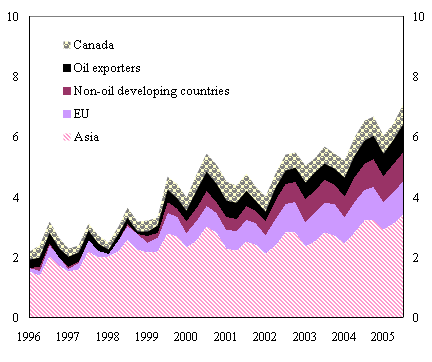Sooner or later, as is true with China and other Asian nations with which we have big trade deficits and which buy Treasuries with some of the dollars they rake in, the oil nations are likely to decide that the US is not the best place to park their money. A sudden shift away from US investments could be catastrophic all around. A gradual one might not be so unstabilizing in the global sense.
Regardless, the outlook for the US is probably -- at best -- one of higher interest rates and slower growth.
What's needed, in order to reduce global imbalances and avoid a world-wide economic meltdown, is the same litany of actions as we've heard before: The US -- its government and its people -- must decrease spending and -- its people anyway -- increase saving. The rest of the developed world plus the oil nations and the emerging economies in Asia should save less and spend more. Asian export nations, particularly China, must stop giving artificial support to their currencies. The European Union must stimulate its economies. The developing nations must reform themselves so they can again attract foreign investment. And the oil nations must spread their wealth around, judiciously, both within and outside their borders.
Here's one of the interesting graphs that accompany the speech, plus the citation and some extracts:
United States’ Bilateral Trade Deficit (in percent of U.S. GDP)

Obviously, the US continues to buy more from than it sells to these trading partners -- more and more each year.
Petrodollar Recycling And Global Imbalances
Presentation by Saleh M. Nsouli1
Director, Offices in Europe
International Monetary Fund
At the CESifo's International Spring Conference
Berlin, March 23-24, 2006
The surge in oil prices in recent years has been taking place in an environment of rising global imbalances. Starting around 1996, a large current account deficit in the United States has been matched by surpluses primarily in other advanced economies and in emerging Asia, and has been accompanied by corresponding shifts in net foreign asset positions. To promote adjustment, policy advice has focused mainly on the need to promote savings in the United States and to foster expenditure in Asia, while moving to more flexible exchange rates arrangements. The impact of these recommendations has been limited so far, and large imbalances persist.
The doubling of oil prices during 2002-05 has made the group of oil-exporting countries a major player on the global current account imbalances scene. The increase in oil prices has shifted large additional sums of money from oil-consuming to oil-producing countries. How oil exporters "recycle" this revenue becomes a crucial issue, not only in determining the economic development of their countries in the future, but also in affecting the orderly narrowing of the global imbalances.
Oil exporters are close to becoming more important than Asia in the holding of net savings outside the United States. While Asia's current account surplus is projected to have risen to US$341 billion in 2005 (equivalent to 47 percent of the United States' current account deficit), that of oil exporters is projected to have reached US$296 billion (equivalent to 41 percent of the United States' current account deficit).
According to IMF projections, oil exporters' current account surplus would amount to 46 percent of the U.S. deficit in 2006, while the figure for Asia would drop to 41 percent.
An assessment of oil futures markets suggests that a considerable proportion of the recent shock should be permanent in nature. The rise in value of oil exporters' petroleum reserves since 1999 would imply a US$850 billion increase in their permanent income.
Oil exporters have not been the main "actors" affecting the United States' large and growing current account deficit. Growing net imports from Asia, and in particular China, have played the most significant role in explaining the overall expansion of the U.S. trade deficit, which has risen from some 2 percent of GDP in 1996 to over 7 percent in 2005.
What are oil exporters doing with the extra oil revenue? Given the large government share in the oil sector in most oil-exporting countries, and thus in oil revenue, the deployment of the additional oil income is mainly the decision of governments.
oil exporters have turned into large buyers of goods from Asia, a region where they also sell the bulk of their oil.
A large share of the oil revenue is being held as investment abroad.
Oil exporters' preference for investing their petrodollars in the United States has alleviated pressures on the cost of funds from high oil price-driven outflows of dollars.
This may have kept U.S. long-term interest rates low, even as the U.S Federal Reserve has hiked its short-term rate to rein in inflation. This may have contributed to bolstering consumer spending and growth in the United States, softening the impact of higher oil prices on the industrialized world as a whole. According to latest IMF projections, more expensive energy will have only a modest impact on global growth, which, owing to various factors, should drop to 4.8 percent in 2006, from 5.1 percent in 2005.
[Oil exporters have begun to shift investments away from dollar assets and] may switch part of their investments away from dollar assets faster if interest differentials become less favorable or if they fear capital losses from potential exchange rate movements.
The bottom line remains: adjustment is necessary in current account-deficit and current account-surplus countries, including the increasingly important oil-exporting countries, if the global imbalances are to be reduced. The rising global imbalances suggest that the steps taken thus far are insufficient and that the world economy remains subject to serious risks of a disorderly adjustment.




No comments:
Post a Comment